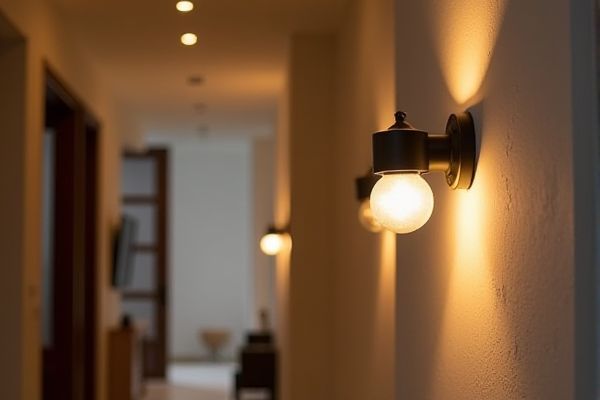
Sconce lighting offers decorative wall-mounted fixtures that provide ambient or accent lighting, ideal for adding style and warmth to your space, while recessed lighting is embedded into ceilings for a sleek, unobtrusive source of general illumination that maximizes room space. Explore this article to determine which lighting option best suits your design needs and enhances your home's atmosphere.
Table of Comparison
| Feature | Sconce Lighting | Recessed Lighting |
|---|---|---|
| Installation Location | Wall-mounted | Ceiling-mounted |
| Space Usage | Saves Floor Space | Invisible, Flush with Ceiling |
| Light Direction | Directional or Ambient | Ambient or Task Lighting |
| Aesthetic Style | Decorative, Adds Design Element | Minimalist, Clean Look |
| Installation Complexity | Moderate, Wall Wiring Needed | High, Ceiling Access Required |
| Maintenance | Easy Access for Bulb Replacement | More Difficult Access |
| Typical Use Cases | Accent Lighting, Hallways, Bathrooms | General Lighting, Kitchens, Living Rooms |
| Cost | Lower to Moderate | Moderate to High |
Introduction to Sconce and Recessed Lighting
Sconce lighting fixtures are wall-mounted units that provide ambient or accent light while adding decorative appeal to your space. Recessed lighting, installed flush with the ceiling, offers a sleek, unobtrusive option ideal for general illumination or task lighting. Choosing between sconce and recessed lighting depends on your design goals, lighting needs, and how you want to highlight architectural features.
Defining Sconce Lighting
Sconce lighting refers to wall-mounted fixtures that provide ambient or accent illumination while adding decorative appeal to any space. Unlike recessed lighting that is installed within the ceiling for a streamlined look, sconces are visibly attached to walls and often feature artistic designs to complement your interior style. This type of lighting is ideal for creating focused light that enhances architectural features or highlights specific areas without overwhelming the room.
Understanding Recessed Lighting
Recessed lighting is installed within the ceiling, providing a sleek and unobtrusive illumination that enhances room ambiance without occupying wall or floor space. These fixtures are ideal for creating uniform lighting or highlighting specific areas, making your interiors appear more spacious and modern. Unlike sconce lighting, which projects light outward and adds decorative flair, recessed lighting offers a minimalist design perfect for subtle, versatile brightness.
Design Aesthetics: Sconce vs Recessed
Sconce lighting offers a decorative element that enhances wall architecture with visible fixtures, creating focal points and adding texture to interior spaces. Recessed lighting provides a minimalist, seamless look by integrating light sources flush with the ceiling, promoting clean lines and unobtrusive illumination. The choice between sconce and recessed lighting often depends on whether the design aesthetic prioritizes ornamental features or a sleek, modern ambiance.
Installation Requirements and Complexity
Sconce lighting typically requires wall mounting with accessible wiring, making installation moderately complex and often suitable for DIY enthusiasts with basic electrical skills. Recessed lighting demands cutting holes into ceilings and running wiring through ceiling cavities, requiring professional expertise to ensure safety and proper insulation. Your choice should consider both your skill level and the structural limitations of your space to avoid costly complications.
Light Distribution and Ambiance
Sconce lighting provides localized, directional light that creates warm, inviting ambiance by casting soft shadows and highlighting architectural features. Recessed lighting delivers broad, even illumination ideal for general lighting needs, minimizing shadows and maintaining a clean ceiling appearance. Choosing between the two depends on desired light distribution--sconces enhance mood and accentuate textures, while recessed fixtures offer uniform brightness for functional spaces.
Energy Efficiency Comparison
Sconce lighting typically uses less energy per fixture compared to recessed lighting, especially when equipped with LED bulbs, as it often illuminates targeted areas rather than whole rooms. Recessed lighting, while offering widespread illumination, can increase overall energy consumption due to the higher number of fixtures required for uniform lighting. You can optimize energy efficiency by choosing LED sconce lights for accent lighting and limiting recessed fixtures to essential zones.
Space Considerations and Room Suitability
Sconce lighting is ideal for small spaces and narrow walls, providing focused illumination without occupying floor or ceiling space, making it perfect for hallways and bathrooms. Recessed lighting suits larger rooms with limited ceiling height, offering a clean, unobtrusive look while evenly distributing light across living rooms, kitchens, or offices. Both lighting options enhance room functionality, but the choice depends on spatial constraints and desired ambiance.
Cost Analysis: Initial and Maintenance
Sconce lighting generally has a lower initial cost compared to recessed lighting due to simpler installation and fewer materials required. Maintenance for sconces is typically easier and less expensive since bulbs are more accessible, whereas recessed lighting often requires ceiling access, increasing labor costs. Considering your budget and ease of upkeep can help determine the most cost-effective option for your space.
Choosing the Right Lighting Solution
Sconce lighting offers decorative appeal and accentuates walls, ideal for creating ambient or task lighting without taking up floor space. Recessed lighting provides a clean, unobtrusive look that distributes light evenly across a room, making it perfect for general illumination and smaller spaces. Your choice depends on the room's size, lighting needs, and design preferences to achieve both functionality and aesthetic balance.
 homyna.com
homyna.com